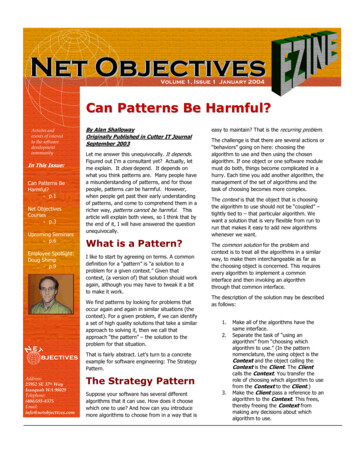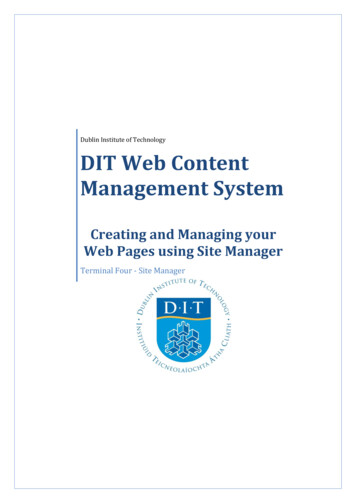
Transcription
Net ObjectivesVolume 1, Issue 1 January 2004Can Patterns Be Harmful?By Alan ShallowayOriginally Published in Cutter IT JournalSeptember 2003Articles andevents of interestto the softwaredevelopmentoommunityIn This Issue:Can Patterns BeHarmful?- p.1Net ObjectivesCourses- p.3Upcoming Seminars- p.6Employee Spotlight:Doug Shimp- p.9BBbjectivesAddress:25952 SE 37th WayIssaquah WA es.comLet me answer this unequivocally. It depends.Figured out I’m a consultant yet? Actually, letme explain. It does depend. It depends onwhat you think patterns are. Many people havea misunderstanding of patterns, and for thosepeople, patterns can be harmful. However,when people get past their early understandingof patterns, and come to comprehend them in aricher way, patterns cannot be harmful. Thisarticle will explain both views, so I think that bythe end of it, I will have answered the questionunequivocally.What is a Pattern?I like to start by agreeing on terms. A commondefinition for a “pattern” is “a solution to aproblem for a given context.” Given thatcontext, (a version of) that solution should workagain, although you may have to tweak it a bitto make it work.We find patterns by looking for problems thatoccur again and again in similar situations (thecontext). For a given problem, if we can identifya set of high quality solutions that take a similarapproach to solving it, then we call thatapproach “the pattern” – the solution to theproblem for that situation.easy to maintain? That is the recurring problem.The challenge is that there are several actions or“behaviors” going on here: choosing thealgorithm to use and then using the chosenalgorithm. If one object or one software modulemust do both, things become complicated in ahurry. Each time you add another algorithm, themanagement of the set of algorithms and thetask of choosing becomes more complex.The context is that the object that is choosingthe algorithm to use should not be “coupled” –tightly tied to – that particular algorithm. Wewant a solution that is very flexible from run torun that makes it easy to add new algorithmswhenever we want.The common solution for the problem andcontext is to treat all the algorithms in a similarway, to make them interchangeable as far asthe choosing object is concerned. This requiresevery algorithm to implement a commoninterface and then invoking an algorithmthrough that common interface.The description of the solution may be describedas follows:1.2.That is fairly abstract. Let’s turn to a concreteexample for software engineering: The StrategyPattern.The Strategy PatternSuppose your software has several differentalgorithms that it can use. How does it choosewhich one to use? And how can you introducemore algorithms to choose from in a way that is3.Make all of the algorithms have thesame interface.Separate the task of “using analgorithm” from “choosing whichalgorithm to use.” (In the patternnomenclature, the using object is theContext and the object calling theContext is the Client. The Clientcalls the Context. You transfer therole of choosing which algorithm to usefrom the Context to the Client.)Make the Client pass a reference to analgorithm to the Context. This frees,thereby freeing the Context frommaking any decisions about whichalgorithm to use.
This solution “solves” the problem because you cannow add more and more algorithms withoutincreasing the complexity of the Context object.What Are PatternsReally About?This is a proper use of the Strategy Pattern. Later I’llshow a case of an improper use of the StrategyPattern.Many people believe that what the Strategy Patternsays is, “when you have a set of potential algorithmsto use, create an interface for all of the algorithmsand have the class that uses the algorithms receive areference to a specific algorithm from a client object”.This shows the problem in a context and shows howthe problem is solved. It boils the pattern down to aclass diagram solution, detailing which class or objectcontains what. Unfortunately, while this is usefulinformation, it is only part of the pattern – a possibleway in which the pattern may manifest itself. Thetruly more valuable aspect of the pattern is not in theclass diagram.Examples of a Strategy pattern design and animplementation for a class that needs to be able toperform different kinds of encryption are shown inFigures 1 and 2, respectively.Note that in this example, we have a Configurationobject that knows which algorithm to use. It couldjust as well been the Client object that knew whichalgorithm to use. The Strategy Pattern does notspecify which object does the deciding of whichalgorithm to use. The pattern just states that theContext object does not do the deciding. It tells youto put the "choosing logic" outside the scope of the“using object."ClientClient gets theAlgorithm objectto use fromConfigClient gives theAlgorithm objectto ContextConfig run(parameters) getAlgorithm()Christopher Alexander states as much at the end ofThe Timeless Way of Building by saying that:Context doAction(Algorithm a)“At this final stage, the patterns are nolonger important: the patterns have taughtyou to be receptive to what is real.” 1Algorithm ree run(parameters) run(parameters) run(parameters)Figure 1. Class diagram for a Strategy Pattern to performdifferent types of encryptionclass Client {Algorithm myAlgorithm;myAlgorithm Config.getAlgorithm();Volume, Issue 1January 2004Volume1, Issue 1 2004, NetJanuary2004Objectives, All 2004, Net Objectives,Rights Reserved.All Rights ReservedbjectivesAddress:Street Address:25952SE 3737ththWayWay25952SEIssaquahIssaquahWAWA 9802998029Telephone:Telephone:(425) s.cominfo@netobjectives.comPatterns ResolveForces. . .myContext.doAction( myAlgorithm);In my classes, I joke that instead of telling me this onpage 545 of a 549-page book, Alexander could havetold me on page 2 and saved me a lot of reading!However, I go on to say that by the time someonereads this, he or she already knows this to be true.“The patterns aren’t important – the forcesin the problem domain and how to resolvethem are.”}class Context {public void doAction( AlgorithmanAlgorithm) {. . .anAlgorithm.run(s);. . .}}Figure 2. Code fragment for a Strategy Pattern to performdifferent types of encryption1I prefer to talk about patterns in terms of the “forces”(the essential constraints and goals andrequirements) in the problem and particular context:what those forces are, how they relate to each other,and how they can be resolved. It is the relationshipof these three issues – problem, context, solution,and the possible resolutions – that is really whatcomprises the pattern.Christopher Alexander is the architect often credited with inspiring many experts in the softwarecommunity to investigate patterns in software. His books The Timeless Way of Building [1] and A PatternLanguage [2] offer tremendous insights to the software design patterns community.2
My hope is to help you to see patterns in this waynow: rather than simply seeing a particularimplementation of a pattern, to be able to stepback and see forces in a problem and how theyare being resolved. This gives you the power andflexibility to address all sorts of problems in thefuture rather than being locked into one specificinstance.Mandates to help youseeforces of the Strategy Pattern, let's look at theprimary mandates of the “Gang of Four.”2 Notsurprisingly, the Strategy pattern reflects all ofthese mandates:1.Program to an interface, not animplementation.2.Favor object-composition over classinheritance.3.Consider what should be variable in yourdesign. Focus on encapsulating theconcept that varies.As a first step in shifting our view from theimplementation of the Strategy Pattern to theNet Objectives - What We DoWhen you’ve taken a course from Net Objectives, you will see the world of software development with newclarity and new insight. Our graduates often tell us they are amazed at how we can simplify confusing andcomplicated subjects, and make them seem so understandable, and applicable for everyday use. Many of ourstudents remark that it is the best training they have ever received.The following courses are among our most often requested. This is not a complete list, though it isrepresentative of the types of courses we offerAgile Development Best Practices - This 2-day course analyzes what it means to be an agile project, andprovides a number of best practices that provide and/or enhance agility. Different agile practices fromdifferent processes (including RUP, XP and Scrum) are discussed.Use Case Based Requirements Analysis - This 3-day course provides theory and practice in derivingsoftware requirements from use cases. This course is our recommendation for almost all organizations, and isintended for audiences that mix both business and software analysts.Effective Object-Oriented Analysis, Design and Programming In C , C#, Java, or VB.net - This 3,4,or 5-day course goes beyond the basics of object-oriented design and presents 14 practices which will enableyour developers to do object-oriented programming effectively. These practices are the culmination of the bestcoding practices of eXtreme Programming and of Design Patterns.Design Patterns Explained: A New Perspective on Object-Oriented Design - This 3-day course teachesseveral useful design patterns as a way to explain the principles and strategies that make design patternseffective. It also takes the lessons from design patterns and expands them into both a new way of doinganalysis and a general way of building application architectures.SW Dev Using an Agile (RUP, XP, SCRUM) Approach and Design Patterns - This 5-day course teachesseveral design patterns and the principles underneath them, the course goes further by showing how patternscan work together with agile development strategies to create robust, flexible, maintainable designsRefactoring, Unit Testing, and Test-Driven Development - This 2 day course teaches how to use eitherJunit, NUnit or CppUnit to create unit tests. Lab work is done in both Refactoring and Unit Testing togetherto develop very solid code by writing tests first. The course explains how the combination of Unit TestingRefactoring can result in emerging designs of high quality.2The “Gang of Four” is a colloquialism for Erich Gamma, Richard Helm, Ralph Johnson and John Vlissides,authors of Design Patterns: Elements of Reusable Object-Oriented Software[4].3Volume 1, Issue 1January 2004 2004, Net Objectives,All Rights ReservedbjectivesAddress:25952 SE 37th WayIssaquah WA es.com
Program to an interface, not animplementation.Chip getAndSendStatus()# encrypt()Essentially this means considering the object youare dealing with as a black box. Do not considerhow it does its tasks, just consider the interface(set of public methods) that it allows you to use.This is very consistent with Bertrand Meyer'snotions of "Design by Contract."3 The Strategypattern follows this approach because eachAlgorithm can only be accessed by theirinterface. The Context object is not aware of anyalgorithm’s implementation.Chip0E# encrypt()This works well for handling one variation.However, if something else starts to vary (say,how you transmit the status or whether you needto compress it before encrypting), you get anexponentially increasing number of possiblecombinations. Using inheritance alone requires acorrespondingly large number of classes (one foreach combination). In older code, we often findan increasingly complex inheritance hierarchyhandling many, many special cases and becomingmore brittle and harder to change as time goesby.Volume, Issue 1January 2004Volume1, Issue 1 2004, NetJanuary2004Objectives, All 2004, Net Objectives,Rights Reserved.All Rights ReservedOn the other hand, if you use the Gang of Four’ssuggestion, you would have the Chip objectcontain a reference to an object that handles theencryption for you (see Figure 4). This would3bjectivesAddress:Street Address:25952SE 3737ththWayWay25952SEIssaquahIssaquahWAWA 9802998029Telephone:Telephone:(425) s.cominfo@netobjectives.comChip128E# encrypt()Figure 3. Handling variation with inheritanceFavor object-composition over classinheritance.When learning object-oriented design, manydevelopers are taught that when an alternativeway is needed to accomplish something,inheritance should be used. In other words, if youhave a class Chip that gets a status of ahardware component, stores it in a string,encrypts that status and then transmits it, you canadd a new kind of encryption by subclassing Chipand overriding the encrypt method (see Figure 3).Chip64E# encrypt()Chip getAndSendStatus()# encrypt()Encryption encrypt(String s)EncryptionW64 encrypt(String s)EncryptionW128 encrypt(String s)EncryptionWNone encrypt(String s)Figure 4. Handling variation using composition (andinheritance)allow you to use polymorphism (or any othermethod of handling variation) to handle thedifferent encryption schemes. If you have otherfunctional variations as well, you could create anew object for each variation. If you are alsofollowing the "design-to-interface" mandate, youcan create as many of these new objects asneeded without greatly increasing complexitysince your existing reference works for all ofthem.The difference between the use of inheritance inSee Object-Oriented Software Construction, Meyer, B. [6]About the author -- Alan ShallowayAlan Shalloway is the CEO and senior consultant of Net Objectives. Since 1981, he has beenboth an OO consultant and developer of software in several industries. Alan is a frequent speakerat prestigious conferences around the world, including: SD Expo, Java One, OOP, OOPSLA. Heis the primary author of Design Patterns Explained: A New Perspective on Object-OrientedDesign and is currently co-authoring three other books in the software development area. He is acertified Scrum Master and has a Masters in Computer Science from M.I.T.4
these two examples is that in Figure 3, I useinheritance on Chip directly while in Figure 4,Chip contains a reference to Encryption, whichuses inheritance. From Chip’s perspective, Iachieve the variation in encryption methodsthrough inheritance while in Figure 4, I usecontainment on the Encryption object.Said another way, in the first case, I am usinginheritance to specialize Chip. In the second case,I am using inheritance to categorize the variousencryption algorithms under a common type.Consider what should be variable inyour design. Focus on encapsulatingthe concept that varies.This mandate was a bit confusing to me at first.4To me, encapsulation meant “data-hiding”. But tothe Gang of Four, it means something else:Encapsulating the concept that varies isencapsulation of type.Notice in Figure 1 how the Client object has nocoupling to the fact that the different concreteimplementations (AlgorithmOne,AlgorithmTwo, AlgorithmThree) even exist.Their existence is hidden (hence encapsulated) byAlgorithm.5 Furthermore, the rules forencryption (i.e., which one should be used underwhat circumstances) are also encapsulated.The Forces in theStrategy PatternNow, I want to look in more depth at the forces inthe Strategy Pattern. They are:1.2.Many potential algorithms (businessrules) exist.There can be many ways the algorithmsvary: Minimal information required todo their tasks Different ways to instantiatethem Different situations in whichthey apply Different persistenceimplications3.Our Client application should not beencumbered with having to know all ofthe business rules possible, as this wouldboth add complexity and limit futurevariation.To resolve these forces, the Strategy Pattern saysto:1.2.3.4.Consider the cost of the Client'sknowing which algorithms it uses. Thisrepresents the potential savings of thepattern.Consider the cost of making thealgorithms interchangeable. Thisrepresents the cost of implementing thepattern.Compare the cost to implement thepattern to the savings it achieves.Decide whether to use the pattern basedon this comparison.This is a bit of over-simplification. Dependingupon the software development practices you arefollowing, both deciding on what the costs are andhow you determine what to do based on themmay vary considerably. This is because what youconsider to be the savings of the pattern isdifferent for different design approaches.Different Approachesto DesignThere are two popular philosophies today aboutdesign. One says developers should do acomplete design before starting to code. Theother says you should start developing a smallpart of the system immediately and guide yourdesign with up-front testing and feedback fromthe customer. As new requirements arise,refactor the design.6 The software is developed insmall iterations (typically 1-4 weeks) allowing youto adjust to feedback from your customer toensure you are on the right track.Evaluating the savings likely will be different forthese different approaches. Those taking a“design up front” point of view, consider thesavings to be all of the savings that will beVolume 1, Issue 1January 2004 2004, Net Objectives,All Rights Reservedbjectives4To be honest, I didn’t fully understand the one about composition either, but I wasn’t confused (justwrong).5This is one reason we sub-titled our book “A New Perspective of Object-Oriented Design”.[7] We didn’tmean that we had come up with a new perspective, but that design patterns themselves create a newperspective. We are just explaining it6Although XP (eXtreme Programming) is in the forefront of this approach, most agile processes endorsesome variant of it. If you are not familiar with XP, I highly suggest reading either Kent Beck’s ExtremeProgramming Explained [3] or Bob Martin’s Agile Software Development: Principles, Patterns and Practices[5].5Address:25952 SE 37th WayIssaquah WA es.com
achieved for the entire system. In other words,the cost of the Client being coupled to thealgorithms includes all algorithms that the Clienteventually needs to know. However, agiledevelopers (particularly Extreme Programmersfollowing the mantra of “doing the simplestthing”) consider only those algorithms that are inthis iteration (and there may be only onealgorithm in this iteration).This "pay now" or "pay later" philosophicaldifference is often at the heart of why somepeople say patterns can be harmful. Someonewith a design-up-front point of view may say,“hey, I’ve got only one algorithm now, but I’mbound to get others later, so I’ll set up aninterface now.” Such individuals believe thatputting in effort now to assist where variationscan emerge later will save time down the road.To join a discussion about this article, please go to http://www.netobjectivesgroups.com/6/ubb.xand look under the E-zines category.Upcoming Free Seminars in the Puget Sound AreaPresenterSeminarDateDan RawsthorneComparing RUP, XP, and Scrum: Mixing a Process Cocktail forYour TeamFeb 26, 2004Scott BainEmergent Design: Design Patterns and Refactoring for AgileDevelopmentApril 1, 2004Dan RawsthorneIntroduction to Use CasesMay 6, 2004Scott BainMock Objects in Endo TestingJune 10, 2004Go to the URL below to register or for more informationwww.netobjectives.com/events/pr main.htm#FreePresentationsSeminars - DescriptionsComparing RUP, XP, and Scrum: Mixing a Process Cocktail for Your Team - This seminar discusseshow combining the best of some popular processes can provide a successful software developmentenvironment for your project.Volume, Issue 1January 2004Volume1, Issue 1 2004, NetJanuary2004Objectives, All 2004, Net Objectives,Rights Reserved.All Rights ReservedbjectivesAddress:Street Address:25952SE 3737ththWayWay25952SEIssaquahIssaquahWAWA 9802998029Telephone:Telephone:(425) s.cominfo@netobjectives.comEmergent Design: Design Patterns and Refactoring for Agile Development - The two approaches ofcreating quality, high-level, up-front designs with design patterns or relying on emergent design usingrefactoring as espoused by XP seem opposed to each other. This seminar illustrates why design patterns andrefactoring are actually two sides of the same coin.Introduction to Use Cases- In this seminar we present different facets of the lowly Use Case; what they are,why they're important, how to write one, and how to support agile development with them.Mock Objects in Endo Testing – This seminar explains the basics of unit testing, how to use unit tests todrive coding forward (test-first), and how to resolve some of the dependencies that make unit testing difficult.If you are interested in any of these offerings, if your user group or company is interested inNet Objectives making a free technical presentation to them, or if you would like to be notifiedof upcoming Net Objectives events, please visit our website, or contact us by the emailaddress or phone number below:www.netobjectives.com ! mike.shalloway@netobjectives.com ! 404-593-83756
The problem with this, however, is that changecan happen anywhere later. Following thisapproach everywhere can both overcomplicateyour design and waste time because you oftenimplement things that are never needed.7If you force-fit a pattern into a situationwhere the pattern doesn't apply, you are,by definition, not following the pattern.The Strategy pattern, however, doesn’t suggestthis. The pattern describes forces. It is up to youto decide if implementing the pattern is calledfor.8 In other words, if you force-fit a pattern intoa situation where the pattern doesn’t apply, youare, by definition, not following the pattern. It istherefore not appropriate to say the pattern itselfis harmful.Using the ForcesWithout theImplementationOn the other hand, the Strategy pattern can bevery useful to an XPer even when he or she writesno code that actually implements the pattern.Consider the previous situation if you werefollowing XP coding practices.9 If, in your currentiteration, you had only one algorithm toimplement, you'd likely have your Client just callit directly. However, you might also recognize thisas a likely place to use a Strategy pattern later ifthere are other algorithms present in futurestories.XP would say the same thing — its codingpractices are geared toward easy code changes.However, the potential need for animplementation of the Strategy patternunderscores this idea and makes you more likelyto follow the XP practices you should. Payingattention to this doesn’t take any extra work orcode; it just reinforces standard XP practices.Let’s consider two XP coding practices: “coding byintention” and “once and only once.”“Coding by intention” says that if, while writingone method, you find you need to implement afunction, pretend a method that accomplishes thatfunction already exists. Give it an intentionrevealing name, write down an appropriateparameter list, and actually implement it later.“Once and only once” means just that — codethings once and only once. In other words, avoidduplication. That way, if a change is required inthe future, we need only touch our code in oneplace.Coding by intention makes it easier to implementthe Strategy pattern because the object using thealgorithm (i.e., the object that will become theContext object if the Strategy pattern is everimplemented) will likely end up having a methodcalled something like “runAlgorithm().” Later, ifyou need to implement the Strategy pattern, youneed only modify this method, causing little or noripple affect to the rest of the code. The once andonly once rule ensures that if there are severalsteps in calling this algorithm, you'd have only oneplace containing these steps (otherwise you'dhave duplication). Thus, knowing that newalgorithms may become available merelyreinforces things you should be doing in XPanyway. In other words, knowledge of theStrategy pattern reinforces the good coding rulesthat XP mandates. It doesn’t require that youimplement the pattern before it is called for.This makes patterns a two-way street. Myawareness of the forces in the patterns assists mein applying XP coding practices. On the otherhand, following XP coding practices makes iteasier to implement the patterns later if they areneeded (this is often called refactoring topatterns).Additionally, the whole idea of incrementaldevelopment, which is at the heart of XP and allagile processes, implies that we should reject theconcept that code must decay in favor of thenotion that code can evolve. To do this, however,we must hold ourselves to a rigorous standard —each time we touch the code we will make it atleast a little bit better— and never any worse.This will lead us to use the Strategy Pattern when7One additional aspect of Agile’s “pay later” approach is to minimize the cost of paying later withautomated testing and risk mitigation.8On the variant of a well-known theme, I will suggest that hammers aren’t bad. Used properly,hammers can be very useful tools. Used improperly, they can be very destructive.9I consider myself an Agile developer, not an XPer, because my approach includes a broader use of thecustomer than XP dictates. However, the issues involved in this article relate almost equally well to allAgile / XP developers.7Volume 1, Issue 1January 2004 2004, Net Objectives,All Rights ReservedbjectivesAddress:25952 SE 37th WayIssaquah WA es.com
Another Example of Patterns as Forces: The Decorator PatternThe Decorator pattern comes into play when there are a variety of optional functions that can precede orfollow another function that is always executed. For example, prior to sending a transmission (which isalways done) it may be that you want to encrypt, compress, translate data-check, or any number of otherthings in any order. How would you best do this? The Decorator pattern’s implementation tells you tomake a linked list of the optional functions ending with the Transmission object. The “decorating” objectsshould all have the same interface as the Transmission object.This implementation can actually be a very bad design. For example, let’s say that these “decorators”(i.e.,the optional functionality) are created by different development groups. Let’s further state that certainexceptions may be thrown by the system and need to be handled by each of the decorators. In a perfectworld, you could have confidence that each of these groups will do what they are supposed to do – catchthese exceptions properly. However, what if they do not? What if an exception is thrown and the groupwriting the code doesn’t catch it? The entire system may crash at this point.Another solution is to have the Client object catch the exception. However, this loses some of the value ofthe Decorator pattern in that your Client object now needs to do more than it did before.A more robust solution is to implement a collection object that has the same interface as the Transmissionobject. This calls the “decorators” and catches any required exceptions in case they don’t. In fact, thismight have the added advantage of making it so the decorating objects no longer needed to have the sameinterface.The point is that you can view the Decorator pattern as having the following forces:1.Several optional functions exist.2.These decorators may or may not be following all of the rules they should.3.You need some way to invoke these decorating objects, in different orders as needed, withoutencumbering the Client object.4.You don’t want to encumber your application with knowing which of these to use (or even thatthey exist).Thinking of the Decorator in this light makes a distinction between the purpose of the Decorator patternand the implementation of the Decorator pattern.Volume, Issue 1January 2004Volume1, Issue 1 2004, NetJanuary2004Objectives, All 2004, Net Objectives,Rights Reserved.All Rights ReservedbjectivesAddress:Street Address:25952SE 3737ththWayWay25952SEIssaquahIssaquahWAWA 9802998029Telephone:Telephone:(425) s.cominfo@netobjectives.comit improves the code in some way; for instance, bymaking the Context object simpler.Misapplying theStrategy PatternIgnoring the forces of the pattern, however, canlead to its improper use regardless of designphilosophy. For example, if the algorithms requireinput data that is widely different for eachalgorithm, it may take as much (or more) work toresolve them all to a common interface. Handlingvarying return data could be just as problematic.This would be akin to forcing a square peg into a10round hole and is counterproductive.Unfortunately, some people will say “The patterntells me to do this.”10 No it doesn't. The patterntells you about forces and a potentialimplementation. Knowing patterns does not meanyou no longer have to think. It just helps youdecide what to think about.To put it another way, the Strategy pattern isabout externalizing a variation in order toencapsulate it. Doing so protects the Contextobject from the variation, but at a cost. If it'sharder to externalize the variation than it is tomaintain it in the Context object, then thepattern does not apply. Of course, the patternPersonally, I don’t think this is any more responsible than saying “the voices in my head told me to dothis.”8
tells you this in the first place.AcknowledgementsIt is easy to do this if you follow logic such as –“patterns are class diagrams, patterns are good, Ishould therefore design like the patterns’ classdiagrams.” You will not make this mistake if youconsider the forces that comprise a pattern.Special thanks to James R. Trott, Alex Chaffee,and the Net Objectives team for assisting me inwriting this article.The naming of patterns, unfortunately, seems tohave emphasiz
software requirements from use cases. This course is our recommendation for almost all organizations, and is intended for audiences that mix both business and software analysts. Effective Object-Oriented Analysi











